Decoding PMS Fee Structures
High net-worth individuals and ultra-HNIs seeking sophisticated wealth management often turn to Portfolio Management Services (PMS). While the potential for high returns is evident, the fee structure can raise eyebrows, shrouded in a fog of misconceptions. But fret not! We’ll shed light on the three main fee options – fixed, profit-sharing, and hybrid – empowering you to make informed decisions.
Myth Buster
The biggest misconception? It’s all about fixed fees, a hefty charge slapped on top of performance gains. Not true! In fact, PMS offers three distinct fee structures, each catering to different risk appetites and preferences. Let’s delve deeper:
- Fixed Fee: Your go-to for predictability. Picture a monthly or quarterly “subscription” charge based on your average portfolio value. This ranges from 0.25% to 2.5%, ensuring fixed costs regardless of market conditions or performance. Think of it as a flat monthly gym membership, giving you access to the expertise regardless of workout intensity. It’s perfect for those seeking stability and budget control.
- Profit-Sharing (Performance Fee): This one puts all your chips on success. You pay absolutely nothing until your portfolio outperforms a pre-defined “hurdle rate” (typically 6% to 10%). Think of it as a performance bonus for your portfolio manager – they win only if you win. But, like a high-commission salesperson, exceptional returns can translate into hefty fees. If your portfolio shines, be prepared to share the spoils, potentially up to 22% of the profits exceeding the hurdle. Ideal for adventurous investors comfortable sharing windfalls.
- Hybrid Fee: Seeking a “balanced diet”? The hybrid model offers a taste of both. You pay a smaller fixed fee (lower than the fixed-only option) along with a performance fee on profits exceeding the hurdle rate. Think of it as a combined gym membership and personal trainer fee. You get access to the expertise with a base cost, but exceptional performance deserves a special reward for the trainer. This suits risk-conscious investors who appreciate both predictability and the potential for performance-based rewards.
Read: A Proactive Approach to Portfolio Management
Fee Structure Dictates Portfolio Construction
False alarm! Regardless of the fee structure, the portfolio manager’s primary objective is to maximize your returns within your risk tolerance. The fee structure simply determines how their success translates into compensation.
Making the Right Choice: What Fits You?
Choosing the ideal fee structure hinges on your individual preferences:
- Risk Tolerance: If volatility gives you jitters, the fixed fee offers peace of mind. But if you’re comfortable with risk and excited about potential windfalls, profit-sharing might be your match. The hybrid fee strikes a middle ground for balanced investors.
Read : Systematic Trading: Mastering Risk Management and Drawdowns
- Investment Goal: Are you seeking steady capital appreciation or striving for exceptional returns? Align your fee structure with your goals. Fixed fees ensure predictable growth while sharing profits in the performance-based models can accelerate wealth accumulation.
- Control Preference: Do you prefer fixed costs? Or are you comfortable with potentially higher fees for exceptional performance? Choose the structure that gives you the desired level of control over your investment costs.
| Fee Type | What is it? | Fee Range | Hurdle Rate Range | Options |
| Fixed | The portfolio managers charge only fixed % on the average portfolio value | 0.25% – 2.5% | Not applicable | Fixed fee only |
| Profit Sharing | The portfolio managers take a % share in profit. Charged only if the portfolio is in profit excess of hurdle rate ** | 13.75% – 22% | 6% – 10% | Profit sharing only |
| Hybrid | Portfolio managers charge a certain % of fixed fee and also take % share in profits, only if the portfolio profit > hurdle rate ** | Fixed: 0.5% – 2.5% | 6% – 18% | Fixed fee + Profit sharing |
| All 3 Options | Where the portfolio managers offer all three options – fixed fee, profit sharing and hybrid fee options. Investors can select any one option | Investor can choose one from the three | ||
Conclusion
Understanding the nuances of PMS fee structures is paramount for investors seeking a sophisticated and personalized approach to wealth creation. Each fee option comes with its advantages and suits different risk tolerances. The fixed-only fee structure provides stability and predictability, making it ideal for those prioritizing peace of mind. Profit-sharing models suit investors comfortable sharing profits with portfolio managers, offering performance-based fees but with potential escalation for exceptional returns. The hybrid fee structure strikes a balance, offering a mix of fixed and performance-based fees for a lower cost compared to fixed-only options.
Before selecting a PMS fee structure, investors must assess their risk tolerance, comfort with potential fees, and desired control over costs. By demystifying PMS fee structures, investors can make informed decisions aligned with their financial goals. In the intricate world of investments, knowledge becomes the key to unlocking success.


